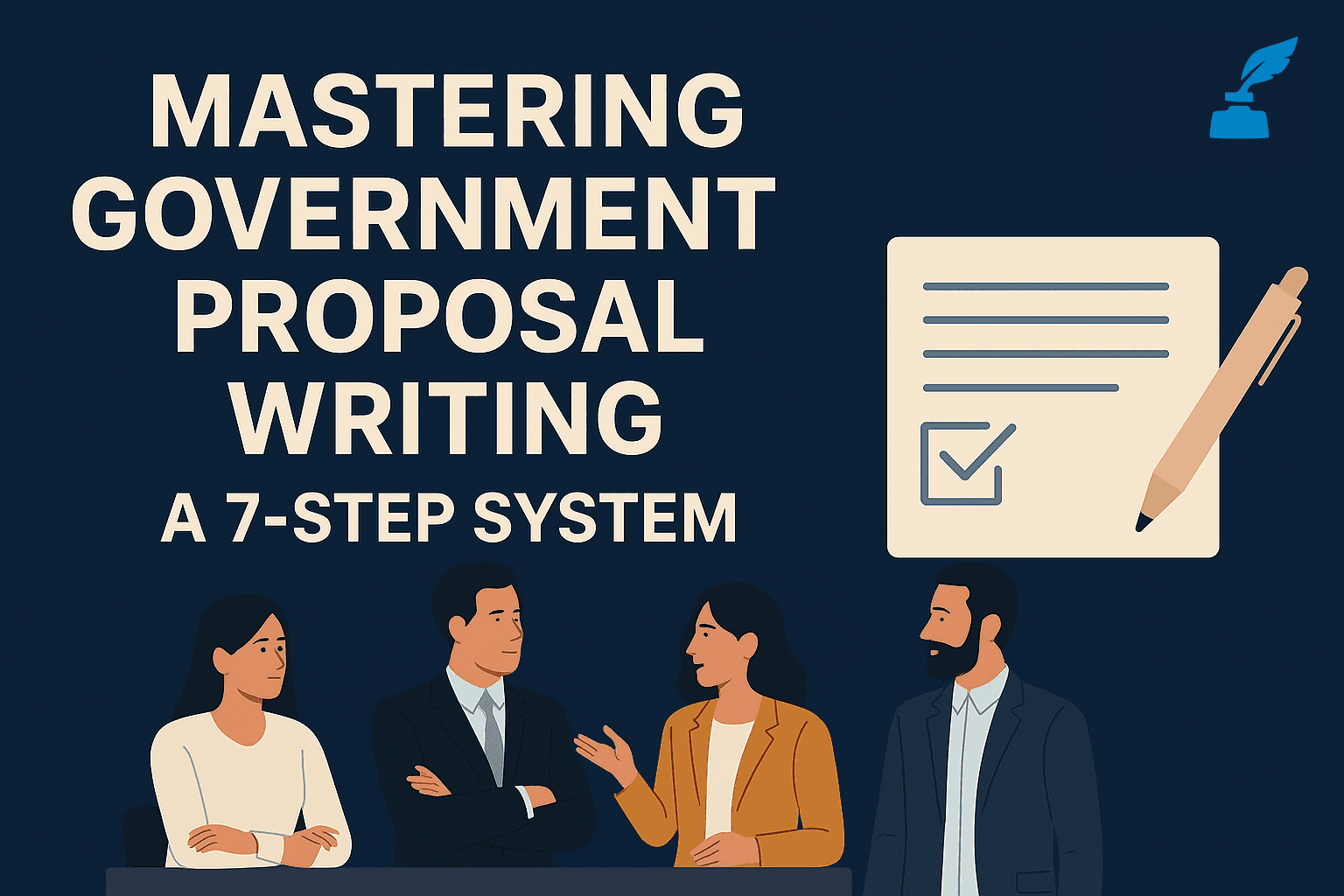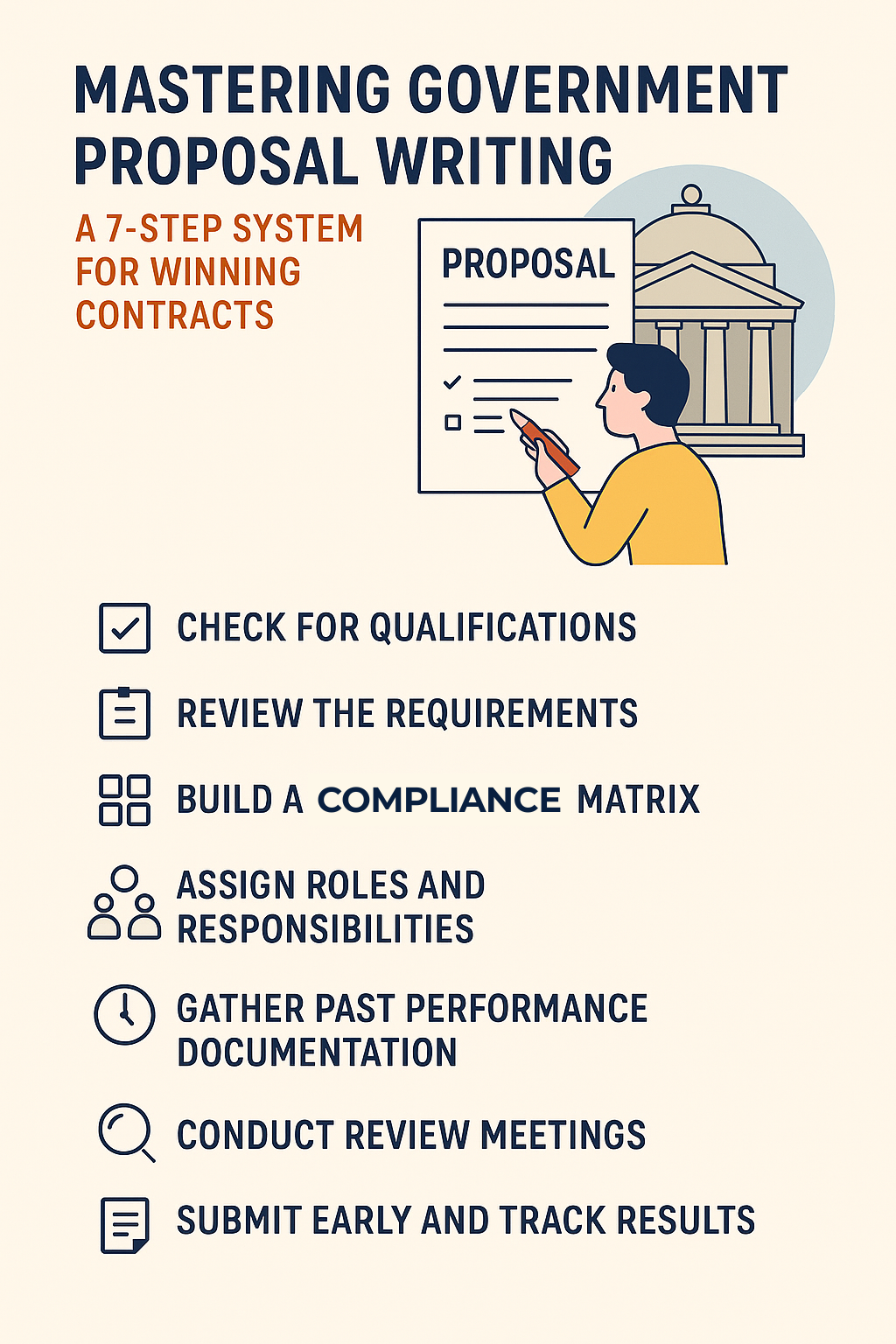How to Write a Winning Proposal in 7 Easy Steps

Quick read: Learn the exact 7-step process to write compliant, competitive government proposals that win contracts.
If you want to win government contracts, mastering proposal writing is not optional—it's essential.
In this guide, we break down a proven 7-step proposal writing system designed specifically for federal solicitations. Whether you're responding to an opportunity on SAM.gov, GSA eBuy, or another platform, this framework will help you demonstrate technical competence, compliance, and past performance—the three pillars of winning in the government space.
🎥 Prefer video? Watch the full breakdown here:
Why Proposal Writing Matters in Government Contracting
Federal agencies evaluate contractors not just on capability, but on how well they follow instructions. Many qualified vendors lose out simply because they miss a requirement or submit late. This 7-step system ensures you build compliant, compelling proposals every time.
👇 I made this infographic below to summarize all the steps:

🔎 Step 1: Confirm Eligibility
Before you begin writing, make sure you're eligible to bid:
-
Read Sections L & M of the RFP (Instructions to Offerors & Evaluation Criteria)
-
Verify Set-Aside Requirements (e.g., 8(a), SDVOSB, HUBZone)
-
Validate Registration
- Confirm your NAICS code matches the opportunity
- Ensure your SAM.gov registration is active and up to date
▶️ Pro Tip: Not reading Sections L & M carefully is one of the top reasons proposals are rejected.
📄 Step 2: Analyze Solicitation Requirements
Next, dig into the RFP and identify exactly what’s required:
- Highlight all “shall” and “must” statements
- Break down technical deliverables and pricing structures
- Identify submission formats and deadlines
This step lays the foundation for a fully compliant proposal.
📊 Step 3: Build a Compliance Matrix
A compliance matrix is a critical tool that maps solicitation requirements to your proposal content.
It should:
- List every requirement (especially from Sections L, M, and the SOW)
- Show where each requirement is addressed in the proposal
- Be used by internal reviewers and often submitted with the proposal
⚠️ Missing this step increases your risk of non-compliance, which is a leading cause of disqualification.
👥 Step 4: Assemble Your Proposal Team
Strong proposals aren’t written alone. Build a capable team:
- Proposal Manager – Oversees timelines and task assignments
- Technical Writers – Draft solution-specific content
- Cost Estimators – Build and justify the pricing volume
- Reviewers – Check for quality and compliance (see color team reviews below)
📁 Step 5: Gather Past Performance Documentation
Most solicitations ask for examples of relevant past performance. Don’t wait until the last minute:
- Identify 2–3 past contracts (federal or commercial)
- Request Past Performance Questionnaires (PPQs) early
- Use the required format (or SF 330 if applicable)
▶️ Past performance is often weighted heavily in evaluations—make it count.
🟥 Step 6: Review the Proposal (Color Team Process)
Adopt the industry-standard Color Team Review Process:
- Pink Team: Review the early draft for structure and completeness
- Red Team: Evaluate the full draft for clarity, compliance, and win themes
- Gold Team: Executive sign-off on the final version before submission
Each review helps identify gaps, catch errors, and strengthen your narrative.
📤 Step 7: Submit and Track Results
Don't let all your hard work go to waste at the finish line:
- Validate submission requirements (file types, naming conventions, page limits)
- Submit early via the correct portal (SAM.gov, GSA eBuy, etc.)
- Confirm receipt and track status
- Request a debrief if you don’t win—it's a valuable learning tool
🚨 Reminder: Submitting even one minute late can result in automatic rejection.
🎯 Final Thoughts: Compliance + Communication = Contracts
Winning government contracts requires more than technical skills—it requires a deep understanding of what agencies value:
- ✅ Compliance: Meet every requirement
- 🗣️ Communication: Respond clearly and directly
- 📈 Capability: Prove you can deliver
Use this 7-step system to streamline your process and maximize your win rate.
🔗 Watch the Full Breakdown on YouTube
🎥 Watch Now: Mastering Government Proposal Writing: A 7-Step System
📚 Related Resources
- Easiest Government Contracts to Win: A Guide for Small Businesses
- Full Spectrum of Government Opportunities
About Samsearch
Samsearch is an all-in-one platform that streamlines the entire government contracting process. Our solution brings together discovery, management, compliance, and proposal drafting — eliminating the need for multiple disjointed government contracting softwares.













